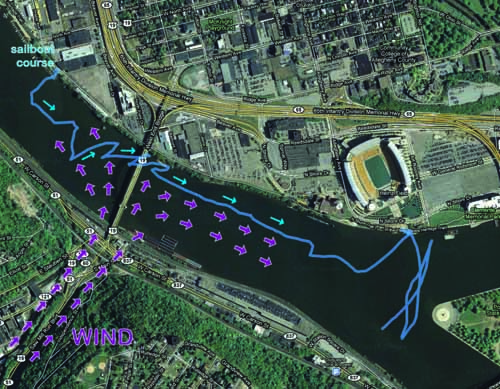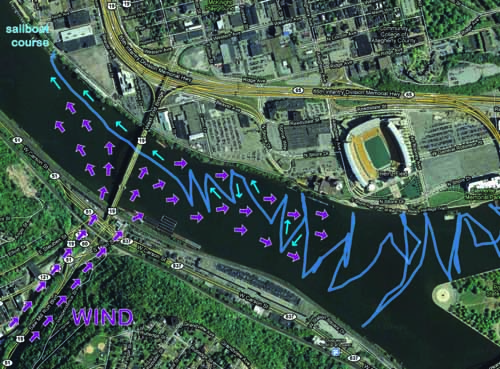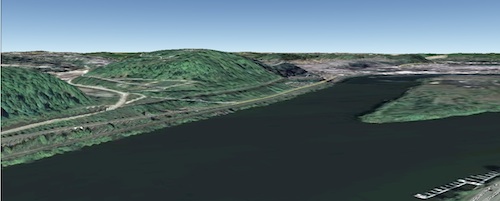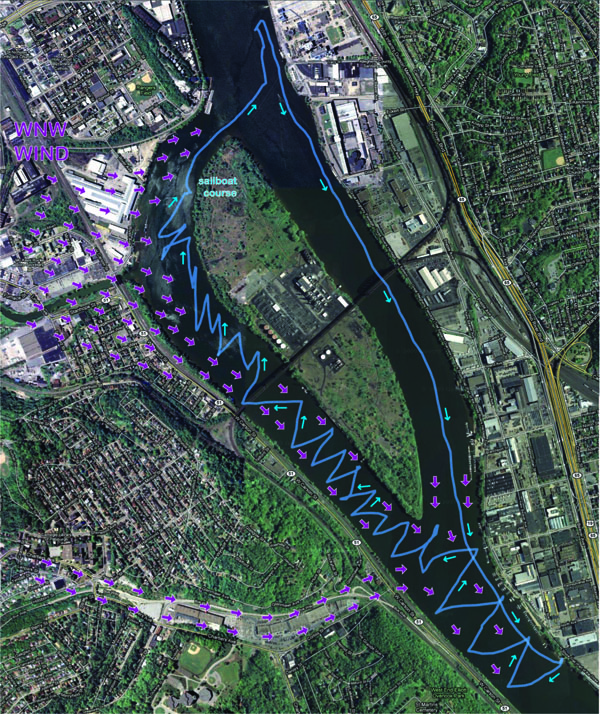Decoding the Winds
The rivers around the Point are shielded on various sides by hills and buildings. So we should expect that the winds will be obstructed and deflected by them. What surprised me is that this deflection is less of a problem than armchair speculation might suggest.
The most important lesson of sailing on the rivers is just this. Time and again, as my GPS tracks show, I found the winds to be funneled along the river course. That means that most sailing on the rivers is done running or tacking into the wind.
There is another, less important lesson. Most of my sailing has been with winds with a Westerly component. These winds are blocked by the ridge of hills that runs in a Northwest-Southeasterly direction along the Southern shores of the Ohio and Mon Rivers. Here's a picture, in which we are looking in North Westerly direction along the Mon and Ohio Rivers, with the ridges along the left:
If there is a reasonable amount of wind--10 mph say--the ridges will not block the wind completely. There will be short periods of dead air. But there will be longer periods of good breezes less than 10 mph; and even occasional gusts beyond 10 mph.
If these Westerly winds have a Northern component, they are Northwest winds. Then they are aligned to blow straight down the Ohio, where the winds will likely be strong and steady. They will continue in this way onto the Mon River, where the sailing will be best. Since the Allegheny runs roughly Southwest to Northeast, these Northwesterly winds will blow across the Allegheny. That means that the stretch of the Allegheny River in front of PNC Park can be shielded pretty thoroughly by the park and other buildings on the Northern shore when the winds are blowing from the Northwest. This can create a pocket of dead air that I have found hard to pass.

The situation is reversed if the Westerly winds have a Southern component, so that they are Southwesterly winds. Then the ridge blocks the winds on the Ohio and the Mon, where the breezes will be erratic. However these same Southwesterly winds are aligned to blow up the Allegheny, where they will provide the best sailing.
Here are some cases in which the experience of sailing on the river and the subsequent gps plots enables us to see fairly precisely how the winds are deflected.
Southerly Winds near the West End Bridge
There is one section of river where I'd long suspected a simple explanation of erratic wind patterns. That section is the Ohio River around the West End Bridge. There is a ridge of hills on the Southern shore and that ridge is broken by a valley just where the West End Bridge crosses the Ohio River.
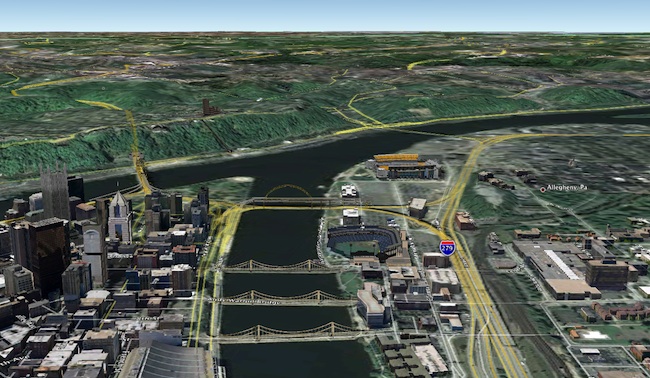
When the winds blow from the South, they are funneled through this valley and delivered to the river course. There they spread out, blowing away from the West End Bridge, both up and down stream. Or at least, this is what I'd always guessed must be happening.
Finally, on July 17, 2010, I manged to get solid evidence that this is the case. It came in the form of the GPS tracks recording my day's sailing from the Newport Marina; upstream to the West End Bridge; past it to the Point and beyond; and then back. The configuration of tacking and running reveals clearly that the wind is spreading out from the point where the valley delivers the wind. (Not sure about what "tacking" and "running" means? See "What it takes...")
Here is the explanation and figures extracted from my narrative for July 17, 2010:
The voyage starts in the upper left corner. After an easy start, it zigzags as I tack into a wind that comes from the East. As I pass the West End Bridge, the wind is coming from the south and my tacks turn towards the South. Finally once I've passed the bridge, the winds are blowing from the West along the river and I sail in a straight line with the wind behind me.
I've extracted this part of the track below and added the direction of the wind.
This track now makes a little clearer why
the stretch of the Ohio River in front of the Newport Marina can be
difficult to sail. If the winds are blowing from the South West, we
might expect winds to blow roughly from the West in that stretch of
the river. However we can now see that these Westerly winds will meet
winds funneled from the valley, blowing in the opposite
direction--and quite possibly do it exactly where I put into the
water. It is hard to say what will result. Perhaps we will have
periods of calm as the winds cancel, or eddies blowing unpredictably.
Either way, it will be hard sailing.
Here's an image of this stetch of
the river that shows two valleys. We are looking South West
across the Ohio River with the West End Bridge at the left and my
starting point, the Newport Marina, is roughly in the middle. The
second valley on the right will also funnel Southerly winds onto the
Ohio but they will blow in the opposite direction of those coming
from the West End Bridge.
The geometry is reversed on the return. In front of Heinz Field and the Science Center, I tack back and forth into a Westerly wind, tacking in symmetrical zigzag across the river. As I near the West End Bridge, the direction of the zigzags changes in response to a wind that blows more from the South. Once I reach the Bridge, the wind is blowing from the East with the current. I have an easy sail back to the marina with the wind behind me.
Here's the relevant part of the track:
This was difficult sailing. In retrospect with the help of a map plotting the GPS track, there is a simple geometric clarity to it all. But it is not so when you are sitting on the deck in the river. All I knew is that the winds seemed to change direction continuously.
Westerly Winds at Brunot Island
On August 16, 2010, I sailed downstream in the channel on the Western side of Brunot Island. The general wind direction was West North West. The experience of sailing there and the subsequent gps tracks revealed similar deflections of wind.
Here is the account drawn largely from the narrative of August 16, 2010.
For most of the length of Brunot Island, there is a hill on the Western shore that will block the wind. There is a valley in the hill that aligns roughly with the upstream tip of Brunot Island. Then the hill ends somewhere in line with the downstream end of Brunot Island.
All this is easier to visualize in this figure. It shows a view looking exactly WNW, the direction from which the wind comes.
The Western channel is on the center-right, so the winds will be delivered to the channel by passing either way round the hill near the center-left of the image and then blowing towards our point of view. That produces uncertain winds all the way along the channel. The most confusing were at the upstream tip of Brunot Island (the lower tip in the map). I follow the wind when I sail on the river. My tortured wriggles near the upstream tip reflect my struggles to chase the wind and still make way into the channel.
My supposition is that wind from three places was meeting here: the valley, the Western channel and the Eastern channel. When they meet, all sorts of instabilities are likely to arise; and I'm not sure I had any chance of reading them.
The winds were easier to read as I got further into the channel. They were blowing round the downstream end of the hill, across the river channel and then turning upstream. That wind pattern is revealed by the zig-zags of my tacking. In the middle of the channel, they are symmetrical, indicating that I was sailing into a headwind blowing upstream. Then, as I get near the downstream end of the channel, the zig-zags turn to to face the West. That is the direction from which the wind is now blowing.
Here's a figure that shows my best estimate of how the winds were being deflected:
East South Easterly Winds at the Point
East South Eastery winds blow steadily downstream along the the Mon and Ohio Rivers. They can be obstructed, however, by the Point and the buildings downtown. Here's a clear case of it from an afternoon sail on August 10, 2014.
The gps track shows me tacking upstream towards the Point in steady zig-zags. I try to sail up the Allegheny, once I approach the Point, but the sailing becomes erratic. I am in the wind shadow of the Point. I return to the Point and resume sailing up the Mon with steady zig-zags, once again.
The wind direction is shown by the arrows. The colored block is the wind shadow, that is, the area of obstructed winds.
John D. Norton
Back to main

